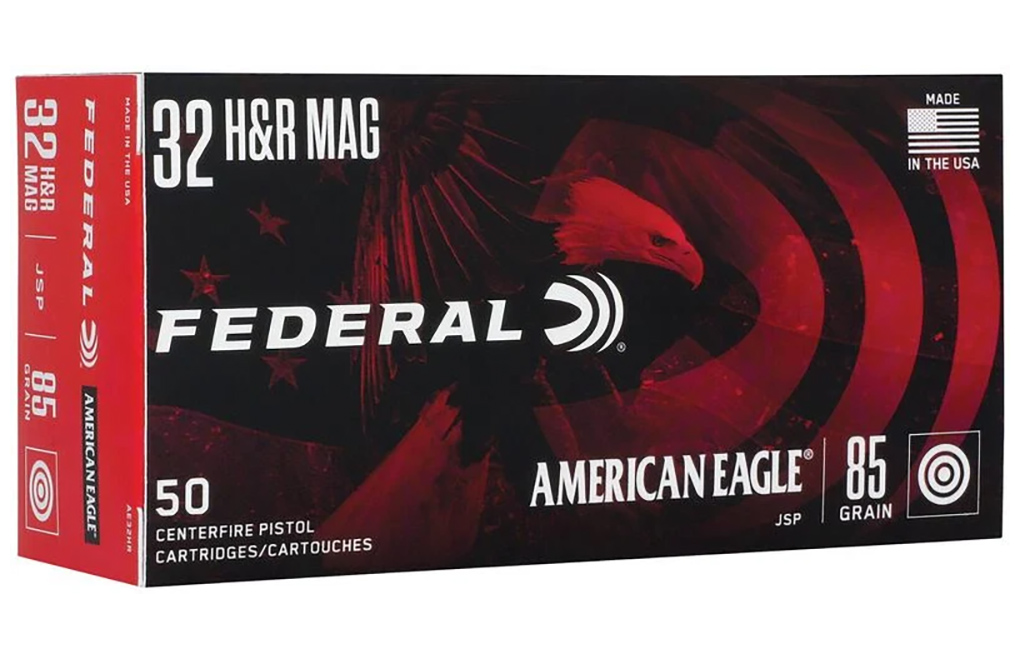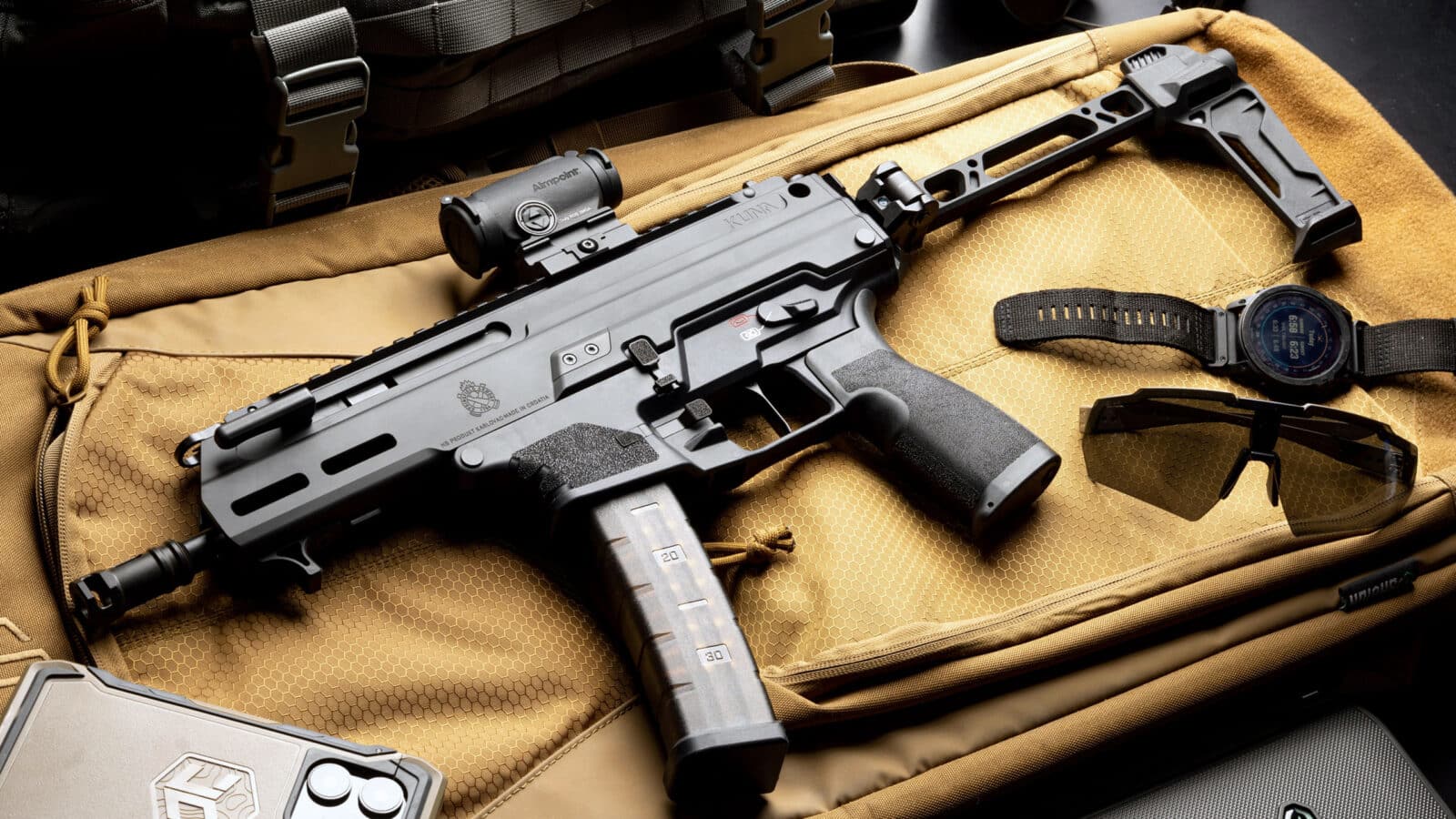When I pick up a 1911, it feels like I’m shaking hands with an old, cherished friend. Our relationship began 60 years ago, when I was in the Air Force, and tried my hand at Bullseye shooting. In the ensuing decades the old warhorse (in a variety of costumes) acted as a home-defense gun, accompanied me on a variety of handgun hunts, participated in many writer events at Gunsite Academy and always had my back. When I first handled the new Hog Hammer built by Finks Custom Gunsmithing, the resident smithy at Gunsite, it felt like I was shaking hands with my new best friend.
It’s Hammer Time
I’m not sure John Browning would have chosen the name “Hog Hammer” for a 1911 handgun, but I believe everything else on Dave Fink’s new creation would have received unconditional approval from Americas greatest gun designer. Both the slide and frame are forged steel, providing beneficial weight to assist in controlling the noticeable recoil of a large-caliber cartridge. Total weight of the gun with the Holosun sight and empty magazine is 2½ pounds. There is no guide rod in the recoil spring, (one of my pet peeves,) so there’s no need to search for a special tool to disassemble and clean the gun; simply rotate the bushing and remove the recoil spring. The pistol uses a single-stack magazine, meaning the gun can be more easily managed by persons with small to medium sized hands. Front and rear serrations facilitate easier operation of the slide, a very helpful feature given the heavier spring weight (20 pounds) required for the 10mm round. The G10 Super Scoop grip panels have a mixture of serrations and “dimples” that, along with the gentle checkering on the front and back straps, help control the weapon’s recoil without tearing flesh. I don’t appreciate being stabbed with needles, not in my arm, not in my butt, and not in my hands.
There are some features on the Hog Hammer that might have puzzled Mr. Browning. The gun has a Cerakote finish that resists corrosion, a treatment not available in the opening decade of the 20th century. Gunsite’s newest 1911 has both of the “proper” safeties, the first being the grip safety which engages and disengages the block in front of the trigger mechanism that allows/prevents the shooter from pressing the trigger. The grip safety has an enlarged bump at its base that insures it is fully depressed/disengaged when the pistol is gripped firmly. Back in the day, the smaller original grip safety caused reliability problems for some shooters. The second safety feature is the thumb safety which can only be engaged and disengaged when the hammer is cocked. Dave Fink has installed an ambidextrous safety on the Hog Hammer so that it can be operated with the thumb of the shooting hand by both right- and left-handed shooters. Some trainers believe the dual thumb safety’s primary purpose is to facilitate running the gun with the support hand in case your dominant hand is disabled. I’m not sold on that idea. I find a right-handed thumb safety is easily (but more slowly) disengaged with the left hand. I’m more concerned with having a second thumb safety that might accidentally be bumped and disengaged when the gun is carried in an open top OWB holster. The ambidextrous safety means the gun is ready to go for both right- and left-handed shooters as delivered. Makes sense.
The Hog Hammer works on the range and in the field.
A Slicked-up Hog
The Hog Hammer comes “dehorned,” a very desirable feature on a defensive handgun, particularly if carried concealed. Both the Hog Hammer’s front and rear iron sights have straight edges and 90-degree corners to ensure the shooter can achieve a precise sight picture in the event he needs to use them instead of the excellent Holosun green dot sight that is mounted on top of the slide just in front of the rear sight. The iron sights are visible through the window of the Holosun. The gun is delivered with both the optic and iron sights shooting to the same point of aim. For you young tactical folks, that’s properly referred to as “co-witnessed battle sights.” The two magazines furnished held 8 rounds, although I understand 9-round mags are available.
Dot sights are taking the handgun world by storm. I use them regularly and to great effect on a pair of hunting handguns, one for big game and the other for varmints. I didn’t originally consider dot sights for defensive use because most encounters are up close, and finding the dot in the window seemed slower to me than getting on target with open sights. A dialog with Gunsite Academy’s CEO Ken Campbell revealed that more than half the new shooters coming through the Gunsite 250 defensive pistol class have dot sights on their handguns, and they’re shooting better scores than the students with iron sights. Ken graciously offered to host a three-day event for some of us writers using dot-equipped pistols, and it was very enlightening. I’m not yet faster with a dot on my Glock 19, particularly at closer ranges, but I’m definitely improving. At 25 yards and beyond, the dots not only outperformed open sights in terms of precise shot placement, they were faster.
Does 10mm Work in Defensive Pistols?
Admittedly the 9mm cartridge has an advantage in a defensive handgun with its lighter recoil, but the 10mm offers some terminal effects well beyond my Glock 19. In fact, my first interest in the 10mm’s hunting capabilities occurred several years ago when Tejon Ranch went to all lead-free ammo. The guides who occasionally had to enter heavy brush to find wounded hogs were carrying semi-automatic pistols chambered in .45 ACP. After some thorough, and sometimes very exciting field tests, they concluded that with lead-free bullets, the 10mm was a better performer. I haven’t run a 10mm through any of Gunsite’s classes or writer events, but our next shoot at the Academy is in December where I will get a chance to run the Hog Hammer through some defensive scenarios. I’m looking forward to that.
The Hog Hammer is throated and tuned to insure reliable operation. All of the ammo tested provided 100-percent reliability. The “test” period extended over a period of three months and included two hog hunts, one in Texas and one at the famed Tejon Ranch in California. The pistol was not cleaned during that period. The gun was sighted in for Double Tap 180-grain Controlled Expansion rounds on the Texas hunt and Double Tap 155-grain Lead Free loads for Tejon in keeping with the hunting laws in central California. Unfortunately, we did not see a pig during daylight hours on the Texas ranch and we were unable to get within proper handgun range at Tejon except for administering the coup de grace on a pig dropped at extended range with a rifle. The recovered 10mm lead-free slug looked exactly like Double Tap’s advertisement.
Testing The Hog Hammer
The literature that accompanies the gun says the trigger pull is set at 4 pounds, 4 ounces. My decades old trigger gauge finally gave up the ghost, meaning I couldn’t verify the exact number, but my trusty old trigger finger confirmed that it was in the vicinity of 4 pounds. The real magic in a 1911 trigger isn’t the weight at which it breaks, but rather the minimal amount of trigger movement required to make the gun fire. Perhaps 1/16 of an inch to take up the slack followed by the most-crisp trigger break in the semi-automatic handgun world. It’s why the best bullseye shooters have been able to shoot scores higher than 2,600 out of a possible 2,700 points at distances of 25 and 50 yards, and that’s with iron sights.
With a Holosun HE407K-GR reflex sight mounted on top of the Hog Hammer, you’ve entered a whole new world of capabilities. Don’t be alarmed by Holosun’s alpha/numeric title; it’s a dot sight with the 6-MOA dot being green rather than red. With unlimited eye relief and a “shake awake” power capability that instantly re-lights the dot at the same intensity as its last setting, your optic is always ready to go. That said, you really should read the instructions, so you understand what settings you dialed in to the compact sight. While the controls are easy to use, there are 12 reticle brightness settings available, two of which are night-vision compatible. Adjustments for windage and elevation couldn’t be simpler. Two clearly marked adjustment screws are located on the top and side of the sight right where they should be, i.e. windage on the side and elevation on top. There’s even a small adjustment tool to help with adjustments and battery replacement, but with a battery life of 50,000 hours with the dot at setting 6, it’s like a lifetime guarantee for shooters in my age bracket.
Using the Holosun sight, group sizes at 25 yards ranged from just over 2 inches to 3 inches when shooting with arms resting on a table. It’s possible these groups might have been smaller had a machine rest been used, but group testing was conducted in the field at the two ranches where we hunted.
Conclusion
Obviously, I can’t say Finks Custom Gunsmithing 1911 10mm will replace all other carried handguns. But a couple years ago, six Gunsite Family Members got together for a hog hunt at Fort Rock Ranch near Kingman, AZ. Guns used were all 10mm, but from different manufacturers and equipped with a mixture of dot optics and iron sights. Every hunter made a one-shot kill, dropping his or her pig where it stood. So, what I can say is this: first the 10mm can successfully terminate potential threats in the 200-pound weight class. Second, the 1911 platform has more that 100 years of successful performance in a variety of different missions. Third, new handgun shooters are performing better using today’s dot sights. The new Hog Hammer checks all three of these boxes. So, when terminal performance out prioritizes concealability, when precise long-range shots rival the importance of quick close-range shots, and when shooter capability outweighs magazine capacity, Gunsite’s new 10mm Hog Hammer is definitely a candidate as a viable full-time companion.
The price of the Hog Hammer 10mm 1911 is $2,499, and more information on this pistol and other guns from Fink’s Custom Gunsmithing is available at finksguns.com.
Read the full article here












Leave a Reply